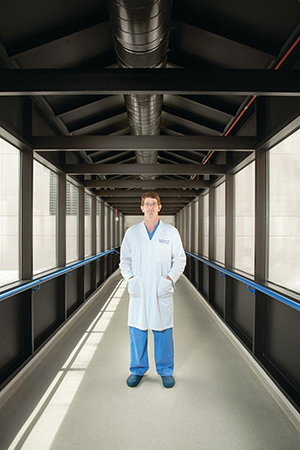From the time of his first knee injury as a high school athlete, Joseph L. Ferguson, MD, DPT, knew he wanted to be an orthopedic surgeon. Now, as a surgeon at MedStar Orthopaedic Institute, he’s fulfilled that ambition with a special focus on treating spinal disorders.
On his way to turning those early ambitions into reality, Dr. Ferguson took a somewhat different career path. While a student in the undergraduate pre-med curriculum at Davidson College, his original interest in medicine gradually shifted to a related discipline— physical therapy.
“It involved physics and sports—everything I loved,” Dr. Ferguson recalls. “It really seemed like a good fit.”
After completing the Doctor of Physical Therapy program at Drexel University in Philadelphia, Dr. Ferguson joined nearby Magee Rehabilitation Hospital, where, during his training, he had been attracted to cases involving brain and spinal cord injuries, and stroke recovery. Dr. Ferguson loved his work, and the stage seemed set for a successful career. He soon realized, however, that his interest in orthopedic surgery had only been sidelined, not silenced.
“I increasingly wanted
something where I could
use my hands in ways that
physical therapy didn’t offer,”
he explains. “Therapy work
can also take a long-term
physical toll on providers,
which might eventually limit
my ability to treat patients.”
Despite having an advanced clinical degree, a shift to orthopedic surgery would mean starting training from scratch—four years of medical school, followed by another six years of internship, residency, and fellowship. “Some people thought I was crazy for even considering it,” Dr. Ferguson says with a laugh. “But I was fortunate to have an incredible, supportive wife who basically said, ‘take the MCAT exam and see what happens.’”
Apart from having a small head start in basic courses like anatomy at Jefferson Medical College in Philadelphia, Dr. Ferguson says the main advantage of returning to school as an adult were time-management skills honed from his experience in the working world. “That’s not always true when you’re 22 years old—something I remember well,” he adds.
Dr. Ferguson came to MedStar Georgetown University Hospital for his residency, and returned last year after a fellowship in Orthopaedic Spine Surgery at Chicago’s Rush University Medical Center. He believes his dual background enhances his treatment skills, especially when helping patients understand elements of the postoperative recovery process.
“If I think physical therapy will help with a certain condition, I can advise the patient on what they’ll need,” he says. “If not, I can explain why focusing on recovery may be a better approach, rather than waste several months on something that may not provide many benefits.”
Dr. Ferguson gets his own kind of physical therapy with the help of two young daughters, and his hobbies of biking and golf. Although his double-dip of medical education and training put some unusual demands on his family, he considers the experience well worth it.
“I think I’m a better surgeon and physician for having done both,” he says. “Overlaying physical therapy with medical knowledge lets me see the patient’s whole picture.”













